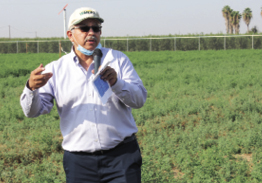New groundwater recharge efforts aimed at alfalfa crop
By Dennis Pollock

Photo/Dennis Pollock
Efforts have been made by nut-crop growers to recharge their underground water supplies by capturing excess water in the winter.
They are far from alone.
Researchers are finding some success in doing that with alfalfa, taking great care not to park so much water for so long that it suffocates the plants' roots.
"I don't think there's any future for field crops in California without flood irrigation," said Khaled Bali, an irrigation water management specialist at the University of California Kearney Agricultural Research and Extension Center in Parlier.
Bali said he believes flood irrigation can be made similar in efficiency to technologies such as drip irrigation. He said it's necessary for groundwater recharge and is taking on a greater importance as California ramps up its regulations under the Sustainable Groundwater Management Act.
At a recent alfalfa and forage field day at the Kearney center, Bali spoke about a two-pronged effort to stretch sparse rainfall benefits in the San Joaquin Valley with winter flooding and summer deficit irrigation of alfalfa. He said some basins in the region are overdrafted and there will be a need to reduce pumping by as much as 30%.
"If we have to survive at 2 acre-feet of water, we need to look really hard at what we can do in the way of groundwater management," he said. "We need to look at how to use recharge to bank water in wet years."
Alfalfa production in the region is from early March through October, and full irrigation is from 40 to 50 inches.
Bali said one of the challenges of groundwater recharge is simply that farmland slopes from 1 to 2 feet in a run of a quarter of a mile. That leads to runoff.
He said growers need to look at soil types and consider infiltration rates.
He said it can take about five to six weeks in February and March to bank 50 inches. He said alfalfa can be sensitive to flooding, with roots suffocating if oxygen in the soil falls below 5%.
Researchers monitored oxygen concentrations and found that they could do one flooding irrigation a week and maintain levels above 5% if they applied about 80 inches at 12 to 13 inches a week. "It had no impact on alfalfa," Bali said.
In 2021, 89 inches were applied in 16 irrigation events over a seven-and-a-half-week period.
"Flooding doesn't affect alfalfa yield," Bali said, "and winter flooding helps with the first two cuttings."
Similar trials at UC Davis mirrored the results at Kearney, said Dan Putnam, UC Cooperative Extension agronomist. "We have to take advantage of the surface water that is available, water that would otherwise rush out to the ocean, capture some of that water for groundwater recharge to pump out at a later time," he said.
He said similar trials at UC Davis showed "profound effects on the first four cuttings."
"This is going to be the norm probably with our water supply," Putnam said.
In a separate presentation, Putnam talked about trials in an alfalfa plot that are in their fourth year. He emphasized that quantity is the most important goal growers should strive for. He added that, as yields increase, a resultant trade-off is a loss in quality.
"Acreage of alfalfa is the lowest it has been since the 1940s in California," Putnam said. "We need high yields."
He emphasized the need to select seeds that will bring high yields and not being too hung up on differences of $1 or $2 per pound, when the results can be increases in yields that can result in differences ranging from hundreds to thousands of dollars.
He said growers also need to look at pest resistance. In the valley, he said, it's wise to choose seeds that have resistance to phytophthora root rot, aphids and stem nematode.
(Dennis Pollock is a reporter in Fresno. He may be contacted at agcompollock@yahoo.com.)
Permission for use is granted, however, credit must be made to the California Farm Bureau Federation when reprinting this item.




